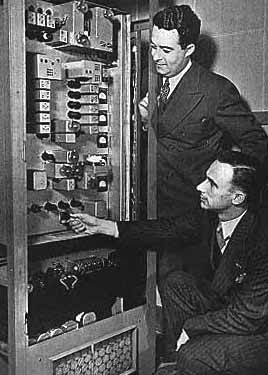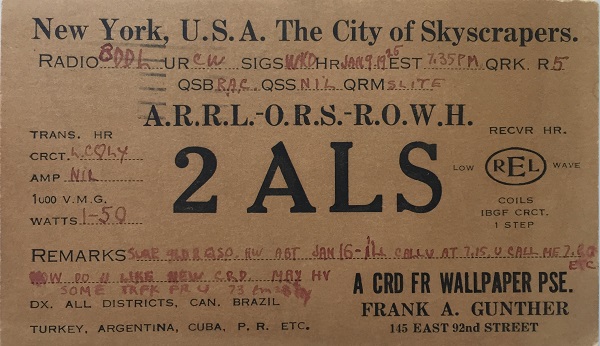 |
 |
President 1974 - 1977 V. President 1968 - 1971 Director 1968 Frank A. Gunther Rego Park, NY Dongan Hills, SI, NY Venice, FL QCWA # 135 Born 1908 President Emeritus Radio Club of America |
 |
VENICE, FL, June 1, 1999--Communications and FM pioneer Frank Gunther, W2ALS, of Staten Island, New York, died here May 31. He was 91. Gunther was in the vanguard of shortwave, two-way and FM radio system development for military and public service applications.
An ARRL Life Member, Gunther was a past president of the Radio Club of America and was trustee of its club station, W2RCA. He also served from 1974 until 1977 as president of the Quarter Century Wireless Association.
In the mid-1920s, Gunther went to work for Radio Engineering Laboratories in Long Island City, New York, where he served as chief engineer. While there, he built and operated an experimental radio station that was among the first shortwave broadcasting systems.
In 1931, he took part in the first public broadcast from an aircraft and installed one of the first airborne two-way radios the following year. Also in 1932, he built what is believed to be the first two-way mobile radio system for the police department in Bayonne, New Jersey.
Gunther was a long-time associate of the inventor and developer of FM, Maj Edwin H. Armstrong. In the late 1930s and early 1940s, Gunther was involved in the installation of nearly all of the FM-band pioneers. Also in the years before World War II, Gunther designed and manufactured LORAN transmitters used by the Allies.
He became president of REL in 1961 and directed the development of the first tropospheric scatter systems for the military. At the time of his death, he was associated with High Point Tower Technology in Oldsmar, Florida.
Gunther also was a QST author. In 1932, Gunther detailed plans for "A Portable 56-Mc. Transmitter-Receiver" in the May issue of QST. He used the article as a platform to urge greater experimentation on the "ultra-high frequencies" (as they were called then). "The amateur's value to the world, and the chances of the amateur playing the big part in future radio that he has in the past, will depend considerably on his knowledge of and connection with development of ultra-high frequencies," Gunther wrote.
Frank A. Gunther, one of America's radio pioneers and the original developer of short wave radio equipment - the genesis of today's wireless transmission industry - died May 24, 1999, in Venice, FL. A Fellow and Past President of the Radio Club of America and a Fellow in the Institute of Electrical & Electronic Engineers (IEEE), Frank had an extraordinary 72-year career in the Radio industry. From installing the 600 meter transmitter-receiver in the sea plane used by Amelia Earhart in 1928, to touring Vietnam as a three-star Lieutenant General to inspect communications installations at the request of the U. S. Army Signal Corps, Frank's career was long and rewarding.
Known to military, police, fire and community leaders around the world, Frank designed, installed and proved the viability of radio communications in an age when few envisioned, and even fewer understood, the enormous potential and impact this field would have on the way we live.
Frank A. Gunther, a radio pioneer who helped create shortwave, two-way and FM systems, died on Monday at Bon Securos Hospital in Venice, Fla. He was 91 and lived in New York and Nokomis, Fla.
Mr. Gunther often worked with the military, as well as with police and fire departments, devising some of the first radio communications devices. In 1932, for example, he built for the police department in Bayonne, N.J., what is believed to be the first two-way mobile police radio system.
In 1928, Mr. Gunther also installed one of the first one-way radios used on an aircraft and, in 1931, he took part in the first public broadcast from an aircraft. A year later, he installed the first two-way radio system on an airplane.
Frank A. Gunther was born on February 3, 1908, in Manhattan. He attended Wagner College, on Staten Island, and Columbia University. In 1925, he joined the REL Radio Engineering Laboratories, based in Queens, and helped construct and operate an experimental station that was one of the first shortwave broadcasting systems.
In 1935, Mr. Gunther, along with Edwin H. Armstrong, gave the first public demonstration of frequency modulation, or FM transmission, a signal much superior in clarity to AM or shortwave. The next year, he designed and manufactured the early transmitter components for FM radio, and from 1939 to 1942, he designed and built more than 25 FM stations nationwide.
In 1939, Mr. Gunther demonstrated the first FM mobile transmitter to the United States military, and during World War II, in which he served as a major in the U.S. Army Air Force, he began designing the first Loran navigational systems for the Coast Guard.
Mr. Gunther, who was also a commercial pilot, became president of REL in 1960 and retired in 1982. Most recently, he worked as a consultant with his son, Robert, president of Highpoint Development of Staten Island, a developer of wireless communication towers.
He was a former president of the Radio Club of America, which established the Frank A. Gunther Award in 1996. The award is given annually to people who make major contributions to the advancement of wireless military electronic communications systems. In 1992, he was featured in a Public Broadcasting Service documentary, 'Empire of the Air: The Men Who Made Radio.'
Mr. Gunther's wife, Lillian Madden, died in 1997. In addition to his son Robert C. of Shrewsbury, NJ, he is survived by a son, Frank M., WA2GMM, of Staten Island; five grandchildren; six great-grandchildren, and five step-grandchildren.
   |
 |
Professionally, Frank joined Radio Engineering Laboratories (REL) in 1925. He became president of REL in 1960. In 1977 he received the DeForest Pioneers-Lee DeForest Award for being Original Developer of Short Wave Radio Equipment, and in 1992 was featured in a PBS television program entitled Empire of the Air, The Men Who Made Radio.
The Radio Club of America established the Frank A. Gunther Award in 1996 for major contributions to the advancement of military electronic communications systems, with Mr. Gunther as the first recipient. Most recently, Mr. Gunther worked as a consultant with his son, Robert, president of Highpoint Development Ltd. of Staten Island. He is survived by his sons, Frank M. and Radio Club member Robert C. Gunther; five grandchildren, six great-grandchildren and five step-grandchildren
